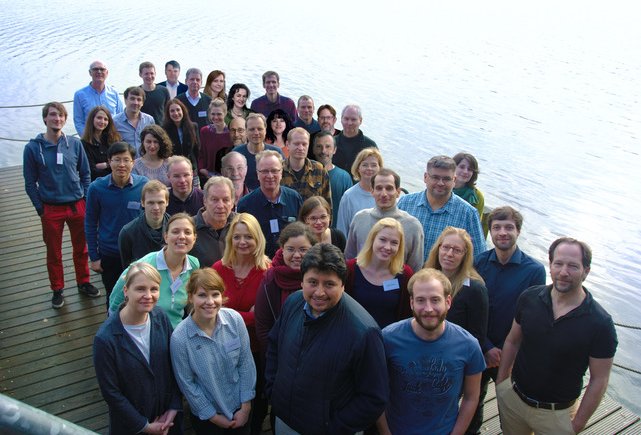The central research topic of the GFZ Section 4.2 'Geomechanics and Scientific Drilling' is towards understanding the physical and physicochemical processes that control dynamics and mechanical properties in the Earth's crust and mantle lithosphere. This covers the entire spectrum of topics ranging from geomechanics and rock physics to the rheology of crust and uppermost mantle, ranging over the entire spatial bandwidth from the laboratory through mine and reservoir scale to the deformation of tectonic plate boundaries. The goal is a quantitative scale-invariant understanding of the mechanics of deformation and mass transport processes in the lithosphere (extremely brittle to fully ductile) and includes the analysis of their spatio-temporal changes and scale dependence from the atomic structure to the regional field scale (reservoir, plate margin). In our laboratories we conduct experiments on deformation and transport processes in reservoir and crustal rocks, for example on granites or porous storage rocks such as sandstone. In experiments in which we heat and pressurize rocks, we investigate seismic and aseismic deformation processes under controlled conditions and with optimal monitoring. From this we derive laws that we then study in nature in geological reservoirs or along tectonic plate boundaries under uncontrollable conditions. We also perform in-situ measurements in mines and in tectonically active areas along plate boundaries. Here we focus on the analysis of processes acting before, during and after earthquakes of different strengths. With our research, we not only discover fundamentals about the mechanical properties of rocks. We also provide physical basics for estimating a range of geo-risks and geomechanical issues in the exploration of the subsurface.

Every earthquake and every landslide proves it: solid rock is by no means as strong and durable as it appears in everyday life. Exposed to sufficiently large mechanical forces, rocks can burst, break or gradually deform plastically. We investigate what happens in particular at such fractions and under which physical conditions rock begins to flow at all, as it is thus deformed. We have at our disposal a laboratory equipped with many sensitive equipment for rock physics experiments. We can put rock samples under high load in different, hydraulically or gas-operated presses. With other devices, we examine the pore space, that is, the voids between the rock particles. We produce brittle fractures in rock samples. This is the same process that is responsible for earthquakes in nature. We also analyze rocks directly from seismic zones, such as a serpentinite, which was drilled three kilometers down the San Andreas Fault in California. These measurements in the laboratory are complemented by comparative investigations in the field. We focus primarily on geological reservoirs and the North Anatolian Fault in western Turkey, one of the most dangerous earthquake zones in the world. For example, we have set up a borehole-based geophysical observatory (www.gonaf-network.org) in the broader Istanbul region, on the Princes' Islands and around the eastern Sea of Marmara, with which we can record even the smallest earthquakes in this area. In addition, we also use temporarily installed local monitoring networks. The recorded seismic waveform data allow us to make statements about how the deformation along the plate boundary is partitioned in space and time to ultimately derive scenarios for the imminent strong earthquake in the region. But we also set up our measuring equipment in one of the deepest pits in the world, the 3.5-kilometer gold mine Mponeng in South Africa. There we record extremely small fractures in the rock and their spatio-temporal sequence in order to learn more about the origin and spread of fracture processes.
Our scientific targets, briefly explained per video
Marco Bohnhoff:Fault-zone drilling and monitoring - where do we go from here? Presentation from the 2020 Conference on the Pohang Earthquake, South Korea, on the role of fault zone drilling and monitoring projects worldwide and the role of the International Continental Scientific Drilling Programme (ICDP) to plan and run such projects.
Grzegorz Kwiatek: Prospects to monitor potential departures from self-arrested ruptures using near-realtime monitoring of induced seismicity during hydraulic stimulations. Presentation from the International Forum on the Pohang Earthquake, 12-14 November 2020, South Korea.
Patricia Martínez-Garzón:The interplay between seismic and aseismic deformation on the North Anatolian Fault Zone. Online seminar at the ERC Tectonic-Fear weekly Seminars, hosted by Prof. Chris Marone from the University of Sapienza, Rome. Presented online on March 28th, 2022.
Thomas Wiersberg: Achivements and goals of the International Continental Scientific Drilling Program and how to get involved. Presentation for Early Career Scientists in preparation of the ICDP 25+2 Conference in Potsdam, Germany




